RetroLisa
--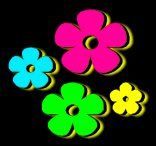 | 1960s Everyday Life
part 2
| |
|
___________________________________________________________________________________________________________
|
|
|
RetroLisa
| ___________________________________________________________________ | __ | _____________________________ | _______ | Genders & Generations
|
| ________________________ | ____________________________ | __ | ___________________________________________ | _______ |
most popular
baby names
of 1965
girls
Lisa
Maria
Karen
Mary
Kimberly
Susan
Patricia
Cynthia
Linda
Donna
|
boys
Michael
James
John
David
Robert
William
Richard
Mark
Thomas
Jeffrey
| |

whatever happened to.....curlers?
Women thought nothing of going to the supermarket with curlers in their hair. Imagine doing that now!
|
| _______________________________________________________________ | __ | _________________________________ | _______ | women in society
In the 1960s, attitudes about women were in a state of transition....
*Young girls were still being taught that the only acceptable careers they could pursue were dancer, actress, stewardess, teacher, model or nurse (as shown in the board game to the right).
*Women were beginning to realize their true potential, thanks to Betty Friedan's landmark 1963 book, The Feminine Mystique.
*NOW (National Organization For Women) was founded by Betty Friedan in 1966.
The Feminine Mystique
NOW (National Organization For Women)

housewives
Once a young woman got married, it was taken for granted that she would give up her career ambitions. It was the husband's job to provide for his family.
The money she spent was given to her as an allowance. She spent her days maintaining the home and caring for the children. Even her social activities were homemaker-oriented: attending Tupperware parties, hosting dinner parties, going to PTA meetings, throwing birthday parties for the kids, and gathering in a neighbor's kitchen for coffee after getting the kids off to school.
Many women found the life of a homemaker quite fulfilling. For others, there was the growing sense that there should be something more....
| |

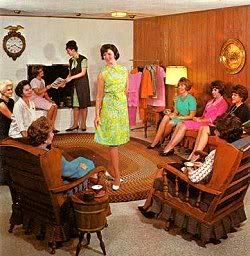
Getting together for coffee and a Beeline Home Fashion Show
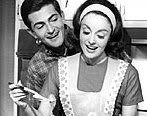
Hey honey, what's for dinner?
|
_________________________________________________
|
|
|
RetroLisa
| ________________________________________________ | ___ | ______________________________________________ | ________ | Holidays
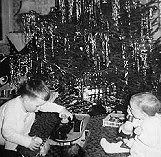
Remember when our Christmas trees were loaded with gobs of icicle tinsel? Which method was better? Laying the icicle strands on the branches one by one, or throwing it on by the handful?
In the old days, icicle tinsel was made of expensive shredded silver. Tinsel manufacturers switched to lead foil and aluminum-coated paper in the 1920s. The new materials were cheaper to produce and resistant to tarnishing. This resulted in an icicle tinsel craze that lasted until the 1970s.
Aluminum was highly flammable and was eventually abandoned for tinsel use. Lead tinsel was fireproof, more attractive and easier to drape over branches. In the 1950s, it became the most common tinsel material.
By the 1960s, metalized plastic tinsel was also available. This product consisted of lightweight plastic strips coated with a non-toxic metal finish. Although not as popular as lead tinsel, it sold relatively well thanks to new health concerns about lead poisoning.
Stylish Christmas trees displayed liberal amounts of flocking. A flocked tree was sprayed with a fluffy fiber concoction to simulate snow. Most flocking was white, but it wasn't unusual to spray your tree with other colors, especially pink and blue.

Shiny-Brite Christmas tree ornaments
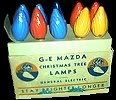
Big colored lights
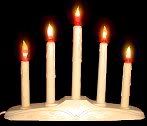
Electric candles glowing in the window
|
|
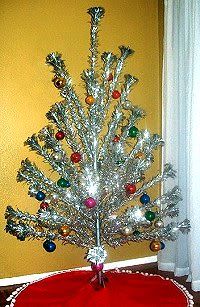
Aluminum Christmas trees were popular from the 1950s to the late 1960s. They were assembled from strips of aluminum-coated paper, which made them highly flammable. Regular lights and electric wiring were a safety hazard, so aluminum trees were lit from below with a spotlight and revolving color wheel. Sometimes the tree itself revolved.
It has been said that the 1965 television special A Charlie Brown Christmas, with its negative view of aluminum trees, was indirectly responsible for the decline of the industry in the late 1960s. The burgeoning back to nature movement of the late 1960s and early 1970s also caused shiny metal trees to fall out of fashion at this time.
Aluminum Christmas Trees
Vintage Decorations
Beyond The 50s

popular Christmas gifts
in the 1960s
- Barbie
- G.I. Joe
- electric can opener
- Beatles albums
- Beatles toy guitars, lunchboxes, etc.
- Viewmaster
- Super Balls
- ladies stretch slacks
- spy toys
- sled
- Hot Wheels
- Poor Pitiful Pearl doll
- Tonka trucks
- Chatty Cathy
- Twister
- Mrs. Beasley doll

holiday songs making
their debut
- Do You Hear What I Hear?
------Bing Crosby (1963)
- Christmas (Baby Please Come Home)
------Darlene Love (1963)
- A Holly Jolly Christmas
------The Quinto Sisters (1962)
- It's The Most Wonderful Time Of The Year
------Andy Williams (1963)
- We Need A Little Christmas
------Mame Original Broadway Cast (1966)
|
__________________________________________
|
|
|
RetroLisa
| ________________________________________________ | ___ | ______________________________________________ | ________ | Trends
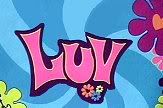
groovy!
In the late 1960s, the mod and hippie movements were starting to have an effect on mainstream society. Posters, products, fashions and home decor were becoming decidedly more groovy.

fear of the bomb
In the early 1960s, the cold war of the 1950s was still very real, and still very frightening. Certain public areas were designated as fallout shelters, and the Emergency Broadcast System conducted tests on radio and TV. Some people purchased or built bomb shelters for their own homes. Bomb shelter mania hit its peak in 1961.
Nuke Pop
Civil Defense In Nebraska
Fallout Shelter Handbook 1962
tell it like it is
*Far out, man! ....it's 1960s slang!
*Stay hip with this 1968 Glossary, you dig?
| |

swinging London
They say that every decade has its trendy international city. In the 1930s it was Berlin; in the 1950s it was Rome. If this is true, then in the 1960s it was definitely London!
The popularity of the Beatles created a desire for all things British. The stylish boutiques on Carnaby Street and King's Road in Chelsea made them the home of mod fashion.
The Mod Scene Online

Swinging Carnaby Street
King's Road In Chelsea
Swinging London

the milkman
A familiar sight in the 1960s was the milkman, driving around in his Divco truck, delivering fresh dairy products right to your front door. Some local dairies still have home delivery, but their numbers are dwindling.
Divco History
From Dairy To Doorstep

|
_________________________________________________
|
|
|
RetroLisa
| ___________________________________________________________________ | __ | _____________________________ | _______ | On The Job
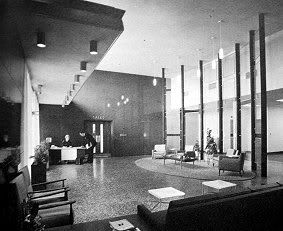
A well-decorated lobby and an attractive receptionist made a positive first impression
office dictation
Dictation machines used several recording formats in the 1960s.
The oldest technology in use was the plastic disc. The Gray Audograph and Edison Voicewriter used discs. Edison's discs were red.
The Dictaphone used blue plastic embossed belts. Portable machines held one belt, while larger models held two belts for up to an hour of recording time. President Johnson recorded many of his speeches and phone conversations on a Dictaphone.
IBM dictating machines used magnetic belts. These belts were not grooved, but were coated with iron oxide like a cassette tape. The sound quality of an IBM recording diminished over time.
Cassette tapes were developed in 1957 for use with dictating machines. In 1963, the Phillips and Norelco Compact Cassette machines were a popular office choice.
office copying
Before the 1960s, all office documents were copied using either carbon paper or a mimeograph machine. Both systems had their drawbacks. Carbon paper couldn't produce large numbers of copies, and typing errors couldn't be erased. Mimeograph machines used messy, smelly chemicals.
Photocopier technology was first developed in 1938. This process uses static electricity, chemically-treated zinc plates and special powders to make copies. The system was perfected and the first photocopier machine went on the market in 1959. This was the Haloid Xerox Model 914.
In 1961, Haloid Xerox changed its name to Xerox Corporation. 40 companies had photocopier machines on the market by the mid 1960s.
document preparation
Electric typewriters were first manufactured in the 1920s, but didn't become widely used in the office until the 1950s and 1960s. IBM introduced their hugely successful Selectric typewriter in 1961. This revolutionary machine replaced the moving carriage and typebars of a regular typewriter with a fixed carriage and typeball.
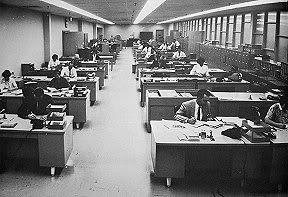
| |

Documents were typed on electric typewriters and stored in metal file cabinets. If your secretary wasn't transcribing dictation from a machine, she was using shorthand and a steno pad to take live dictation.
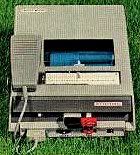
Dictaphone, 1963
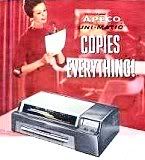
Copy machine, 1961
|
_________________________________________________
|
|
|
